Unit2 Wildlife Protection - reading and thinking 教学课件-2024-2025学年 新人教版高中英语必修二
文档属性
| 名称 | Unit2 Wildlife Protection - reading and thinking 教学课件-2024-2025学年 新人教版高中英语必修二 | 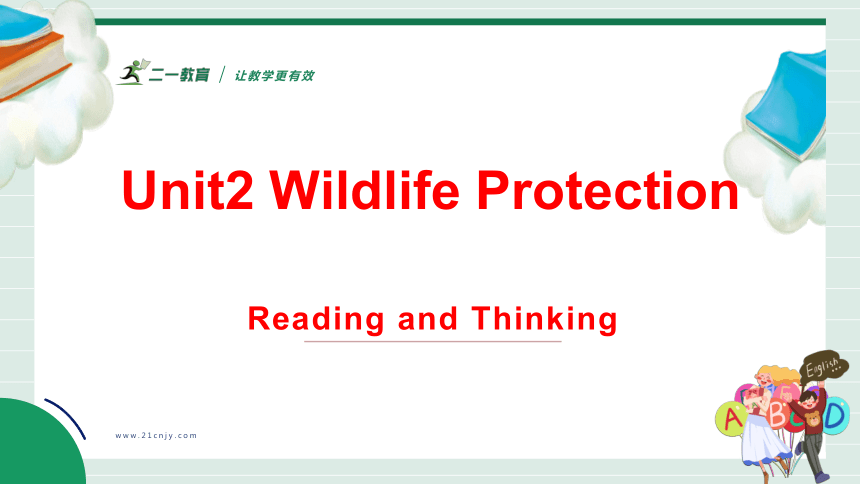 | |
| 格式 | pptx | ||
| 文件大小 | 25.4MB | ||
| 资源类型 | 试卷 | ||
| 版本资源 | 人教版(2019) | ||
| 科目 | 英语 | ||
| 更新时间 | 2024-12-25 08:47:16 | ||
图片预览

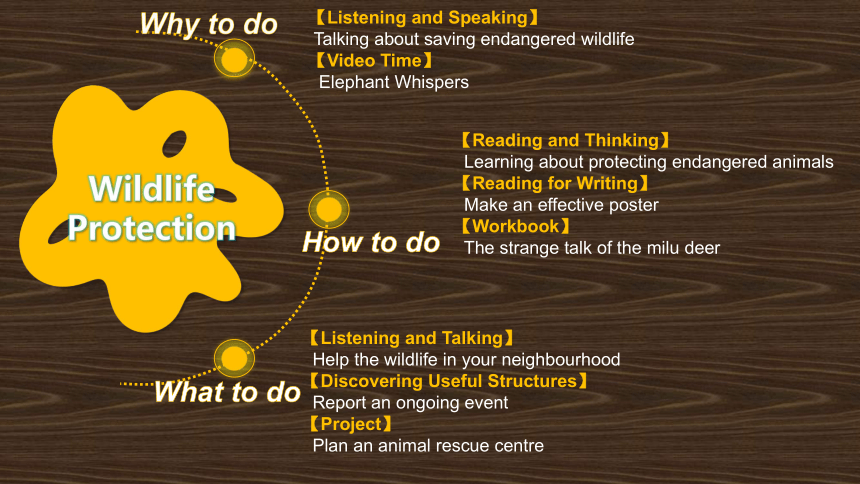
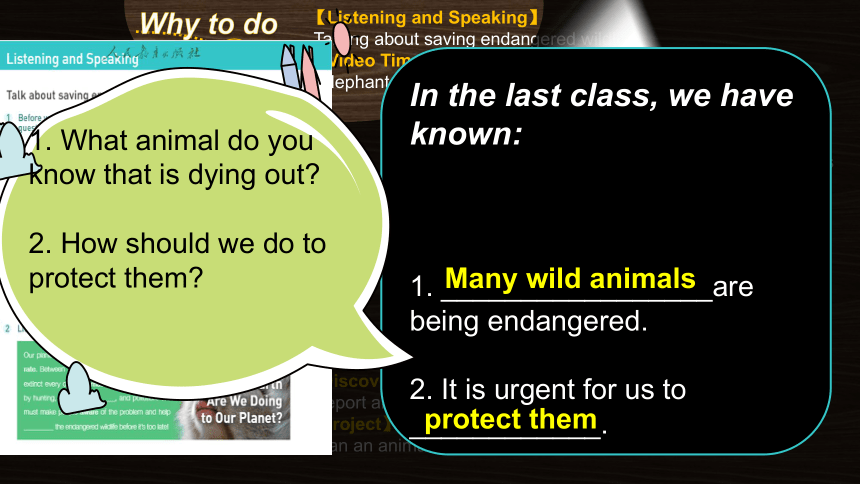
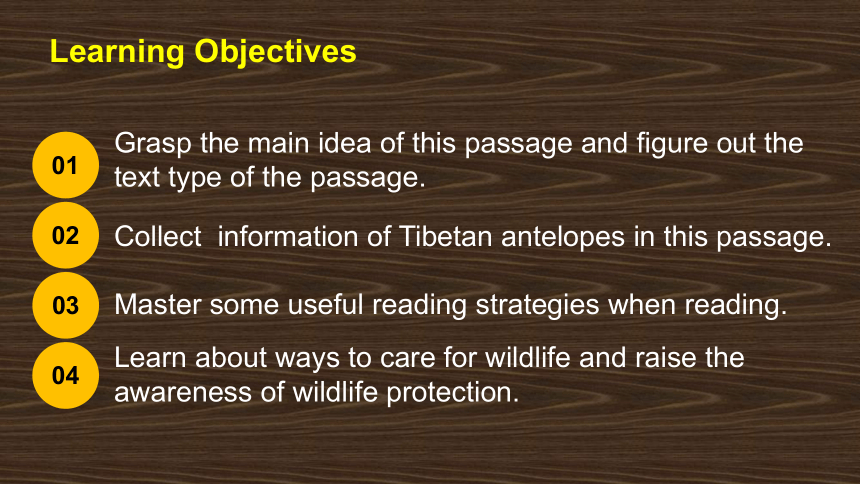
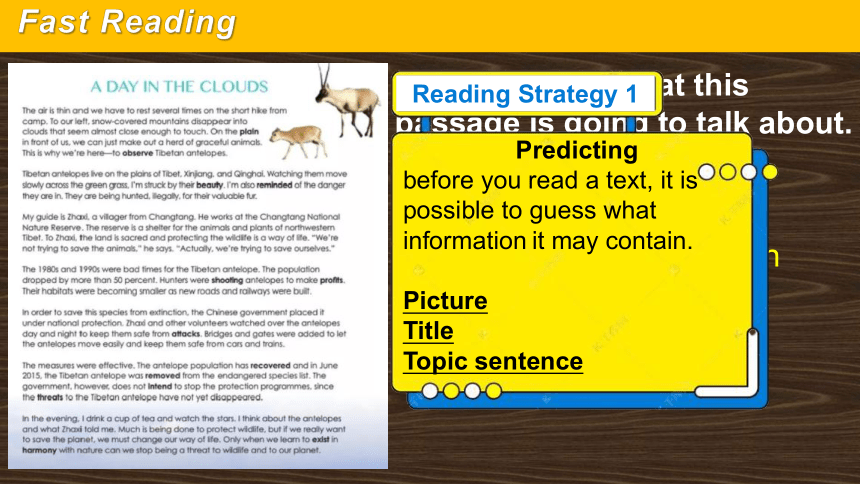
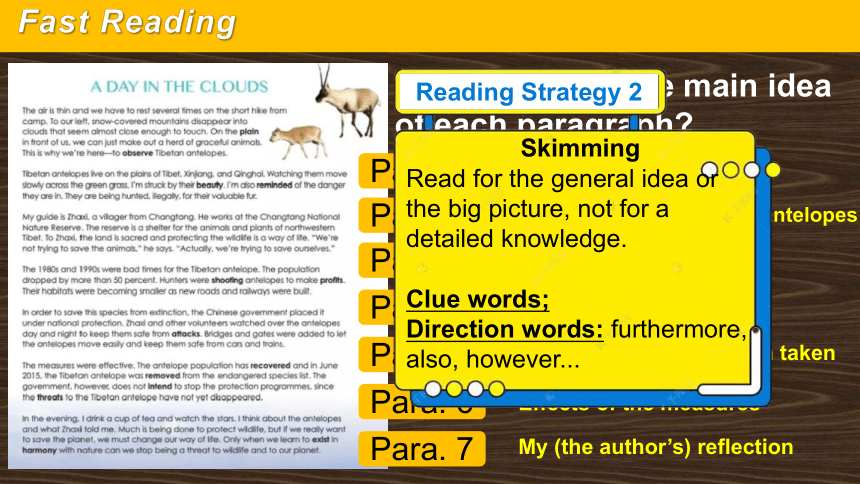
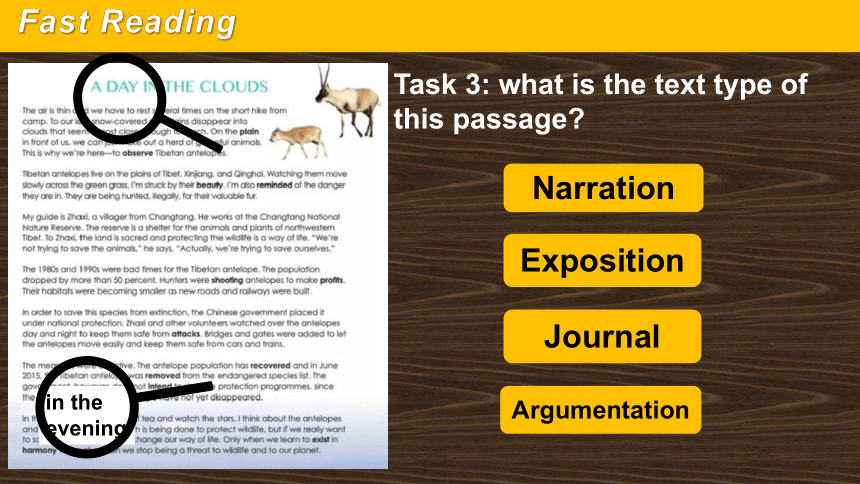


文档简介
(共22张PPT)
Unit2 Wildlife Protection
Reading and Thinking
Wildlife Protection
Why to do
How to do
What to do
【Listening and Speaking】
Talking about saving endangered wildlife
【Video Time】
Elephant Whispers
【Reading and Thinking】
Learning about protecting endangered animals
【Reading for Writing】
Make an effective poster
【Workbook】
The strange talk of the milu deer
【Listening and Talking】
Help the wildlife in your neighbourhood
【Discovering Useful Structures】
Report an ongoing event
【Project】
Plan an animal rescue centre
Wildlife Protection
Why to do
How to do
What to do
【Listening and Speaking】
Talking about saving endangered wildlife
【Video Time】
Elephant Whispers
【Reading and Thinking】
Learning about protecting endangered animals
【Reading for Writing】
Make an effective poster
【Workbook】
The strange talk of the milu deer
【Listening and Talking】
Help the wildlife in your neighbourhood
【Discovering Useful Structures】
Report an ongoing event
【Project】
Plan an animal rescue centre
In the last class, we have known:
1. _________________are being endangered.
2. It is urgent for us to ____________.
protect them
Many wild animals
1. What animal do you know that is dying out
2. How should we do to protect them
01
02
03
04
Grasp the main idea of this passage and figure out the text type of the passage.
Collect information of Tibetan antelopes in this passage.
Master some useful reading strategies when reading.
Learn about ways to care for wildlife and raise the awareness of wildlife protection.
Learning Objectives
Fast Reading
Task 1: Guess what this passage is going to talk about.
A trip to observe Tibetan antelopes.
Reading Strategy 1
Predicting
before you read a text, it is possible to guess what information it may contain.
Picture
Title
Topic sentence
Bad times for antelopes
My (the author’s) reflection
The situation of Tibetan antelopes
Fast Reading
Task 2: What’s the main idea of each paragraph
Para. 1
Para. 2
Para. 3
Para. 4
Para. 5
Para. 6
Para. 7
Introduction to my guide
The reason for my trip
Measures that have been taken
Effects of the measures
Reading Strategy 2
Skimming
Read for the general idea or the big picture, not for a detailed knowledge.
Clue words;
Direction words: furthermore, also, however...
Task 3: what is the text type of this passage
Narration
Exposition
Argumentation
Journal
in the evening
Fast Reading
Questions Information
Things the author sees Para1-2
Things the author hears (from Zhaxi) Para 3-6
Snow covered mountains
The antelopes
Protection of the Tibetan antelopes
In the Day
Reading Strategy 3
Scanning
Again, you read it quickly. However, scanning involves rapid reading for specific rather than general; for particular details rather than the overall idea.
To our left, snow covered mountains disappear into clouds that seem almost close enough to touch. On the plain in front of us, we can just ......
Snow covered mountains
The title: A Day in the Clouds
Watching them move slowly across the green grass, I’m struck by their beauty.
The antelopes
So beautiful !
What should we do
Why
How
Results
What
Measures:
1.__________
2.__________
3.__________
1.______
2.______
What is their condition:______
Why in danger:
1._________
2._________
When
_____________
were bad times
Protection of the Antelopes
The 1980s and 1990s
in danger
hunting for profit
habitat getting smaller
under national protection
volunteers
bridges and gates
population recovered
removed from the list in 2015
Reading Strategy 4
Detailed Reading
Focus on the following ideas and details which support, explain and develop the main ideas.
It involves a slower and more careful reading process.
I think about the antelopes and what Zhaxi told me.
1. We must change our way of life.
2. Only when we learn to exist in harmony with nature can we stop being a threat to wildlife and to our planet.
What did the author do in the evening
The author’s reflection.
Yours
What to do
Why to do it
1.
2.
3.
4.
5.
Share your view with class after discussion.
Why did author say we are a threat
Some possible reasons found from our text book.
Hunters were shooting antelopes to make profit.(P16)
Cities are not suitable for wildlife.(Workbook P70)
The mass extinction is caused by hunting, habitat loss and pollution.(P14)
They are being hunted and their habitat is getting smaller.(P15)
These large animals are being killed illegally for their body parts .(P17)
1.
2.
3.
4.
5.
Share your view with class after discussion.
How to live in harmony with nature
1.
2.
3.
4.
5.
1.
2.
3.
4.
5.
6.
Draw more people’s attention on wildlife protection.(P20)
Start rescue center to protect pets. (P22)
Set up more animal shelters. (Workbook P70)
Stop cutting trees or destroying animals’ habitats.(P20)
Clean up the rivers.(P21)
Do not buy fur or other animal products.(P21)
The Opening Page (P13)
Some possible measures found from our text book.
When the buying stops, the killing can too.
-----WildAid
Mind map what we learnt about the passage.
What the author____
What the author _____
What the author_____
In ______ time
In________
Journal
sees
hears
feels
The protection of Tibetan antelopes
when
what
why
how
the day
the evening
How should we get along with nature
Exist in harmony with it
1. Read Urban Wildlife on Workbook and analyze it with our reading strategies.
2. Find more measures taken or being taken by humans.
Finish the following tasks after class
Workbook P70
Writing P20
Project P23
Workbook P72
https://www.21cnjy.com/help/help_extract.php
让备课更有效
www.21cnjy.com
Thanks!
Unit2 Wildlife Protection
Reading and Thinking
Wildlife Protection
Why to do
How to do
What to do
【Listening and Speaking】
Talking about saving endangered wildlife
【Video Time】
Elephant Whispers
【Reading and Thinking】
Learning about protecting endangered animals
【Reading for Writing】
Make an effective poster
【Workbook】
The strange talk of the milu deer
【Listening and Talking】
Help the wildlife in your neighbourhood
【Discovering Useful Structures】
Report an ongoing event
【Project】
Plan an animal rescue centre
Wildlife Protection
Why to do
How to do
What to do
【Listening and Speaking】
Talking about saving endangered wildlife
【Video Time】
Elephant Whispers
【Reading and Thinking】
Learning about protecting endangered animals
【Reading for Writing】
Make an effective poster
【Workbook】
The strange talk of the milu deer
【Listening and Talking】
Help the wildlife in your neighbourhood
【Discovering Useful Structures】
Report an ongoing event
【Project】
Plan an animal rescue centre
In the last class, we have known:
1. _________________are being endangered.
2. It is urgent for us to ____________.
protect them
Many wild animals
1. What animal do you know that is dying out
2. How should we do to protect them
01
02
03
04
Grasp the main idea of this passage and figure out the text type of the passage.
Collect information of Tibetan antelopes in this passage.
Master some useful reading strategies when reading.
Learn about ways to care for wildlife and raise the awareness of wildlife protection.
Learning Objectives
Fast Reading
Task 1: Guess what this passage is going to talk about.
A trip to observe Tibetan antelopes.
Reading Strategy 1
Predicting
before you read a text, it is possible to guess what information it may contain.
Picture
Title
Topic sentence
Bad times for antelopes
My (the author’s) reflection
The situation of Tibetan antelopes
Fast Reading
Task 2: What’s the main idea of each paragraph
Para. 1
Para. 2
Para. 3
Para. 4
Para. 5
Para. 6
Para. 7
Introduction to my guide
The reason for my trip
Measures that have been taken
Effects of the measures
Reading Strategy 2
Skimming
Read for the general idea or the big picture, not for a detailed knowledge.
Clue words;
Direction words: furthermore, also, however...
Task 3: what is the text type of this passage
Narration
Exposition
Argumentation
Journal
in the evening
Fast Reading
Questions Information
Things the author sees Para1-2
Things the author hears (from Zhaxi) Para 3-6
Snow covered mountains
The antelopes
Protection of the Tibetan antelopes
In the Day
Reading Strategy 3
Scanning
Again, you read it quickly. However, scanning involves rapid reading for specific rather than general; for particular details rather than the overall idea.
To our left, snow covered mountains disappear into clouds that seem almost close enough to touch. On the plain in front of us, we can just ......
Snow covered mountains
The title: A Day in the Clouds
Watching them move slowly across the green grass, I’m struck by their beauty.
The antelopes
So beautiful !
What should we do
Why
How
Results
What
Measures:
1.__________
2.__________
3.__________
1.______
2.______
What is their condition:______
Why in danger:
1._________
2._________
When
_____________
were bad times
Protection of the Antelopes
The 1980s and 1990s
in danger
hunting for profit
habitat getting smaller
under national protection
volunteers
bridges and gates
population recovered
removed from the list in 2015
Reading Strategy 4
Detailed Reading
Focus on the following ideas and details which support, explain and develop the main ideas.
It involves a slower and more careful reading process.
I think about the antelopes and what Zhaxi told me.
1. We must change our way of life.
2. Only when we learn to exist in harmony with nature can we stop being a threat to wildlife and to our planet.
What did the author do in the evening
The author’s reflection.
Yours
What to do
Why to do it
1.
2.
3.
4.
5.
Share your view with class after discussion.
Why did author say we are a threat
Some possible reasons found from our text book.
Hunters were shooting antelopes to make profit.(P16)
Cities are not suitable for wildlife.(Workbook P70)
The mass extinction is caused by hunting, habitat loss and pollution.(P14)
They are being hunted and their habitat is getting smaller.(P15)
These large animals are being killed illegally for their body parts .(P17)
1.
2.
3.
4.
5.
Share your view with class after discussion.
How to live in harmony with nature
1.
2.
3.
4.
5.
1.
2.
3.
4.
5.
6.
Draw more people’s attention on wildlife protection.(P20)
Start rescue center to protect pets. (P22)
Set up more animal shelters. (Workbook P70)
Stop cutting trees or destroying animals’ habitats.(P20)
Clean up the rivers.(P21)
Do not buy fur or other animal products.(P21)
The Opening Page (P13)
Some possible measures found from our text book.
When the buying stops, the killing can too.
-----WildAid
Mind map what we learnt about the passage.
What the author____
What the author _____
What the author_____
In ______ time
In________
Journal
sees
hears
feels
The protection of Tibetan antelopes
when
what
why
how
the day
the evening
How should we get along with nature
Exist in harmony with it
1. Read Urban Wildlife on Workbook and analyze it with our reading strategies.
2. Find more measures taken or being taken by humans.
Finish the following tasks after class
Workbook P70
Writing P20
Project P23
Workbook P72
https://www.21cnjy.com/help/help_extract.php
让备课更有效
www.21cnjy.com
Thanks!
